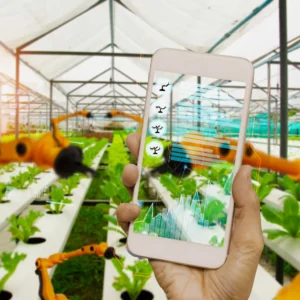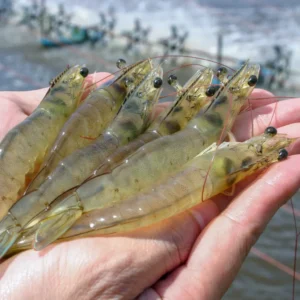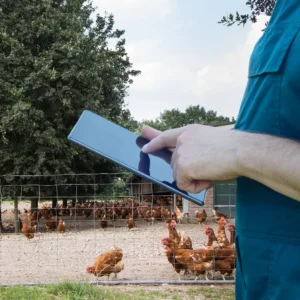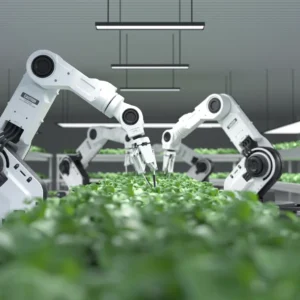
From Farm to Table
AI in Agricultural Supply Chain
Welcome to the realm of AI in the Agricultural Supply Chain, where innovation meets cultivation, and technology transforms the farm-to-table journey. In this article, we embark on an exciting exploration of how Artificial Intelligence is revolutionizing the agricultural industry.
From innovative storage solutions that optimize crop preservation to the precision of accurate demand predictions, AI is redefining how we approach agriculture. We’ll uncover how machine learning paves the way for efficient route planning, reducing costs and environmental impact. Real-time monitoring ensures quality, while AI chatbots solve supply chain queries instantly.
But this journey goes beyond the present; it looks ahead to the future, where AI promises self-regulating farms and a more sustainable approach to agriculture. Join us as we chart the course of AI in agriculture, reshaping how we grow, distribute, and enjoy our food.
Table of Contents
Smart Storage Solutions for Crops
In the ever-evolving landscape of AI in the Agricultural Supply Chain, intelligent storage solutions for crops have emerged as a game-changer. Imagine a warehouse that knows when your crops need ventilation or cooling when to reduce humidity, and when to maximize airflow, all thanks to AI in crop storage optimization. This technology doesn’t just preserve produce; it extends its shelf life, reducing waste and increasing profits.
But it doesn’t stop there. AI goes hand in hand with ML for demand forecasting. Picture this: your storage facility, powered by machine learning, predicts market demands with remarkable accuracy, ensuring you stock just the right amount.
Efficiency skyrockets with AI-driven route optimization. Trucks follow the most innovative routes, cutting costs and reducing carbon footprints. Based on analytics in agri-supply chain efficiency, these decisions mean you get your customers to produce faster, fresher, and cheaper.
What if you could track your product’s journey in real-time using real-time tracking with AI? That’s another triumph of technology. It’s not just about logistics; it’s about accountability and transparency.
And here’s the cherry on top: AI in producing quality assurance. Machines can now spot imperfections, and sort produce faster than human hands. Quality is assured, and your reputation remains untarnished.
The question arises: How do we manage all these intricacies efficiently? Enter AI chatbots for supply chain queries, ready to answer your questions 24/7.
But wait, there’s more to discover! What if we could predict sales trends with precision, optimizing profits? This brings us to the next tantalizing topic: Predictive analytics for crop sales. How do these algorithms work their magic? Let’s find out as we dive into “Accurate Demand Predictions.”
Accurate Demand Predictions
Building on the foundation of intelligent crop storage solutions, we delve into the art of “Accurate Demand Predictions” within AI in the Agricultural Supply Chain. How can AI take us from storing crops efficiently to forecasting demand precisely?
By harnessing the power of ML for demand forecasting, AI algorithms analyze historical data, market trends, and even factors like weather patterns. This amalgamation of insights allows us to anticipate demand fluctuations with remarkable accuracy.
But how does it all come together seamlessly? Enter AI-driven route optimization, our next stop in this journey. How can machine learning plot the most efficient routes for transporting crops, ensuring they reach consumers at the right time and cost?
Discover this next frontier in the agricultural supply chain, where algorithms streamline routes to perfection, and the future unfolds with each delivery. How does it work? We’re about to embark on “Route Planning with Machine Learning.”
Route Planning with Machine Learning
From predicting demand accurately, we step into the dynamic realm of “Route Planning with Machine Learning” in the context of AI in the Agricultural Supply Chain. How does machine learning enhance the logistics behind getting crops from farm to table?
AI-powered route optimization ensures precise truck routes. Machine learning algorithms consider real-time traffic data, weather conditions, and even unexpected road closures. But that’s not all – they also consider the varying shelf lives of different produce, ensuring that the most perishable items reach their destinations swiftly.
AI recalculates routes on the fly, adapting to changing conditions and re-routing trucks to avoid delays. This isn’t just about efficiency; it’s about minimizing waste and ensuring that consumers receive fresher, higher-quality products.
Now, as we explore the landscape of “Boosting Productivity Through Analytics,” consider this: How can data analytics further fine-tune our agricultural supply chains, making them even more efficient and sustainable? We’re on the brink of discovering the next frontier in agri-logistics.
Boosting Productivity Through Analytics
Building on the foundation of efficient route planning with machine learning, we embark on a journey to “Boost Productivity Through Analytics” within AI in the Agricultural Supply Chain. How can analytics amplify the efficiency we’ve achieved so far?
Picture this: Data analytics algorithms, fueled by analytics in agri-supply chain efficiency, dissect every aspect of the supply chain. They scrutinize everything, from the performance of storage facilities to the optimization of transportation routes. These insights uncover hidden inefficiencies and present opportunities for improvement.
But it doesn’t stop there. With predictive analytics for crop sales, you can make data-driven decisions that maximize profits. Did you know that analyzing historical sales data, market trends, and weather patterns can help determine the best time to launch your product and maximize your return on investment? By taking advantage of this information, you can make informed decisions and succeed tremendously in your business ventures.
Let’s contemplate the next frontier: “Real-time Monitoring of Produce Movement.” How can real-time data tracking further elevate the quality and efficiency of our agricultural supply chains? We’re on the cusp of discovering how technology keeps us informed at every stage of the journey from farm to table.
Real-time Monitoring of Produce Movement
Continuing our exploration of cutting-edge technologies within AI in the Agricultural Supply Chain, we now peer into the world of “Real-time Monitoring of Produce Movement.” How can real-time data tracking revolutionize the agricultural logistics landscape, you ask?
Imagine having complete visibility over your produce’s journey, from the farm to the consumer’s table, all thanks to real-time tracking with AI. Every step, every temperature fluctuation, and every route deviation is instantly accessible. This isn’t just about monitoring; it’s about ensuring the freshest and highest-quality goods reach consumers.
But it doesn’t end here. AI can analyze this real-time data to predict potential issues and suggest corrective actions. Consider the possibilities: anticipatory vehicle maintenance, adjusting storage conditions based on weather updates, and optimizing real-time routes.
Now, as we delve deeper into “Ensuring the Quality of Goods with AI,” ponder this: How can AI-driven quality assurance redefine the standards of excellence in the agricultural supply chain? We’re on the brink of discovering how technology safeguards the integrity of our produce.
Ensuring the Quality of Goods with AI
Having glimpsed the wonders of real-time produce monitoring, we now plunge into “Ensuring the Quality of Goods with AI” within the AI Agricultural Supply Chain. How does AI elevate quality control in this intricate supply chain?
But it doesn’t end there. These systems can also detect anomalies in temperature, humidity, and handling conditions, flagging issues in real time. Imagine catching and addressing potential quality problems before they escalate, preserving product integrity and reducing waste.
Let’s ponder this: How can AI chatbots answer the myriad supply chain queries that inevitably arise in this complex ecosystem? As we dive into “Answering Supply Chain Challenges via Chatbots,” consider how AI-powered conversations can streamline operations and enhance customer experiences. We’re on the verge of exploring another facet of AI’s impact on agricultural supply chains.
Answering Supply Chain Challenges via Chatbots
Building upon the advancements in quality control through AI, we now venture into “Answering Supply Chain Challenges via Chatbots” within the AI in the Agricultural Supply Chain. How can AI-driven chatbots tackle the intricate issues in this complex landscape?
Imagine having instant access to a 24/7 virtual assistant powered by AI chatbots for supply chain queries. These intelligent bots are ready to answer real-time questions about shipment status, delivery schedules, and inventory levels. They ensure swift and accurate communication, reducing delays and improving customer satisfaction.
But that’s not all. These chatbots can also assist in managing supply chain exceptions and unforeseen disruptions. They can re-route shipments, adjust inventory levels, and provide solutions to unexpected challenges, all while optimizing efficiency and minimizing losses.
Now, consider this: How can AI precisely predict sales trends, optimize profits, and reduce waste? As we embark on “Sales Predictions for Optimal Profits,” envision the possibilities of harnessing AI to make data-driven decisions that reshape the agricultural supply chain’s financial landscape. We’re on the cusp of exploring how AI can elevate profitability to new heights.
Sales Predictions for Optimal Profits
Expanding on the capabilities of AI-driven chatbots, we delve into the intriguing world of “Sales Predictions for Optimal Profits” within the AI in the Agricultural Supply Chain. How can AI algorithms enhance profitability and reduce waste through precise sales forecasting?
Imagine a scenario where AI analyzes historical sales data, market trends, and consumer behaviour, empowered by predictive analytics for crop sales. These algorithms can forecast demand granularly, allowing businesses to plan production, distribution, and pricing strategies with surgical precision. No more overstocking or underestimating; it’s all about optimizing resources and maximizing profits.
Moreover, these AI systems can adapt to real-time changes. For instance, if unexpected factors like adverse weather impact sales, the AI can swiftly adjust strategies, minimizing losses and ensuring efficient use of resources.
Now, as we contemplate the landscape of “Celebrating Streamlined Agri-Logistics,” consider this: How can an optimized supply chain, empowered by AI, not only boost profits but also contribute to a more sustainable and efficient agricultural industry? We’re on the brink of exploring the broader impact of AI in revolutionizing agricultural logistics.
Celebrating Streamlined Agri-Logistics
In the wake of precise sales predictions driven by AI, let’s explore the captivating realm of “Celebrating Streamlined Agri-Logistics” within the AI in the Agricultural Supply Chain. How does optimizing the supply chain contribute to a more efficient and sustainable agricultural industry?
Imagine an agricultural supply chain where every component, from crop storage to route planning, is finely tuned, thanks to AI-enhanced agriculture logistics case studies. This orchestration minimizes waste, reduces carbon footprints, and ensures fresher produce on consumers’ tables. It’s not just about profitability; it’s about responsible resource management and environmental stewardship.
Moreover, AI doesn’t just react to challenges; it anticipates them. By employing AI-driven route optimization, it proactively adapts to changing conditions, ensuring the smooth flow of goods even in the face of unexpected disruptions.
As we delve into “Charting the Future of AI-Driven Agri-Supply Chains,” consider this: What possibilities await us as AI continues to evolve and redefine agricultural logistics? How will these innovations shape the future of farming and food distribution? We’re on the brink of unravelling the limitless potential of AI in agriculture.
Charting the Future of AI-Driven Agri-Supply Chains
Having journeyed through the transformative landscape of streamlined agricultural logistics, we now set our sights on “Charting the Future of AI-Driven Agri-Supply Chains” within the AI in the Agricultural Supply Chain. What lies ahead as technology continues to reshape the world of farming and food distribution?
Picture this: AI’s integration into agriculture is not a mere trend but an evolutionary leap. As AI algorithms become sophisticated, they will redefine every aspect of farming, from planting to plate, ensuring optimization. The future promises an era of self-regulating farms, where machines, guided by data-driven decisions, tend to crops with unparalleled precision.
But it’s not just on the farm; AI’s influence extends to every link in the supply chain. Real-time data analytics will evolve into predictive insights, allowing businesses to meet and anticipate consumer demands, minimizing waste, and maximizing profits.
AI-powered innovations will also contribute to sustainability by enabling us to produce more food with fewer resources in an environmentally friendly manner. As we stand on the precipice of the AI-driven agricultural revolution, the question is: What will the future hold, and how will AI continue to shape our agri-supply chains in the years to come?
Conclusion
In conclusion, the journey through the world of AI in the Agricultural Supply Chain has been nothing short of remarkable. We started by exploring “Smart Storage Solutions for Crops,” witnessing how AI optimizes storage, thus reducing waste and costs.
Next, we uncovered the power of “Accurate Demand Predictions.” AI’s ability to forecast market trends with precision ensures that agricultural products are well-stocked and utilized.
Our journey took us to “Route Planning with Machine Learning,” where AI optimizes logistics, reducing emissions and increasing efficiency. We then dived into “Boosting Productivity Through Analytics,” where data-driven insights identify hidden inefficiencies and drive more intelligent decisions.
“Real-time Monitoring of Produce Movement” showed us how AI provides transparency and quality control. Then, we discovered how “Ensuring the Quality of Goods with AI” revolutionizes quality assurance.
“Answering Supply Chain Challenges via Chatbots” demonstrated the power of AI-driven communication in streamlining operations. Meanwhile, “Sales Predictions for Optimal Profits” revealed how AI optimizes profits and sustainability.
Our journey culminated in “Celebrating Streamlined Agri-Logistics,” where we saw AI’s role in minimizing waste and environmental impact. Finally, we contemplated “Charting the Future of AI-Driven Agri-Supply Chains,” envisioning a future of precision farming and sustainable practices.
As we conclude, one thing is clear: AI’s integration into the agricultural supply chain is not just a trend but a transformative force. It enhances efficiency, reduces waste, and contributes to sustainability. The question now is not whether AI will continue to reshape this industry but how far it will go. How will the future unfold, with AI continuing to redefine and elevate our agri-supply chains, ensuring a more efficient, sustainable, and prosperous future?
Related Articles
- AI in Smart Agriculture – Precision Farming
- AI in Modern Aquaculture – Underwater Harvest
- AI in Animal Farming – Tech Meets Livestock
- AI in Sustainable Agriculture – Green Gains
- AI in Agricultural Biotechnology – Bespoke Crops
- AI in Agri-Finance and Insurance – Safeguarding the Harvest
- AI in Farming Tools and Machinery – Equipped for the Future
- The AI Urban Farming Revolution – Cultivating Cities
- AI in Agricultural Automation – Robotic Revolution
- AI in Post-Harvest Care – Beyond the Harvest
- The Surge of Agri-Tech AI Platforms – Digital Farming
- AI in Combatting Crop Diseases – Healthy Harvests
- AI in Boosting Organic Farming – Natural Nurturing
- AI in Agricultural Supply Chain Management
- AI in Precision Agriculture: Farms for a Sustainable Future
- AI in Crop Forecasting and Analysis: New Agricultural Era
- The Role of AI in Agricultural Robotics: Revolutionizing Farming
- AI in Smart Greenhouses: Revolutionizing Sustainable Agriculture

Arindam Roy
An Automation Consultant with 25+ years of IT Experience
Forbes Articles related to AI usage in the Agriculture Sector:























